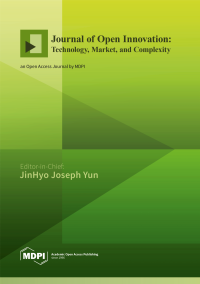Ambidextrous Open Innovation: Technology, Market and Complexity
A special issue of Journal of Open Innovation: Technology, Market, and Complexity (ISSN 2199-8531).
Deadline for manuscript submissions: closed (31 December 2020) | Viewed by 159424
Special Issue Editors
Interests: open innovation; business model; open innovation economy; social open innovation; Schumpeterian dynamics; complexity; game theory; political economics
* Managing Guest Editors.
Interests: technology management; entrepreneurship; creativity and innovation cluster
Special Issue Information
Dear Colleagues,
This Special Issue will publish some selected papers from the annual conference of SOItmC 2020. Suitable topics include but are not limited to:
- Dynamics open innovation;
- Business models;
- Open innovation engineering;
- Open innovation of electronics;
- Schumpeterian economics;
- Artificial intelligence;
- Block chains;
- Smart cities;
- Sharing economy;
- Complexity;
- Smart wearable technology;
- Machine intelligence in mechatronics and robotics;
- The impact of fire protection and safety technologies;
- Construction education;
- Innovation diversity for emerging economies;
- Digital innovation and governance policy;
- Open innovation—the role of Japan;
- Quantum management, Oriental wisdom, and management innovation;
- The 4th Industrial Revolution—a sustainable innovation;
- Dynamics of open innovation in the biomedical industry;
- Open innovation and technology commercialization;
- Technology, innovation, and collaborative governance;
- Innovation performance;
- Knowledge transfer and convergence identification with intellectual property strategy;
- The roles of HR, organizational capabilities, and open innovation in the 4th Industrial Revolution;
- Innovation, entrepreneurship, and sustainability;
- Digital transformation and innovation in the public sector;
- Green governance;
- Digital innovation and entrepreneurship;
- Industry innovation ecosystem design and strategic development;
- Open innovation and strategic competitiveness;
- Measuring business excellence and case studies for sustainability;
- Patent analysis and open innovation;
- Innovation ecosystem for sustainable development in China;
- Beyond innovation, beyond smart cities;
- Entrepreneurship and technology-based firms;
- Climate change and enhancement of public awareness toward industry;
- Stories about the Korean innovation companies from start-ups and ventures to medium-large enterprises;
- Transdisciplinary research and education in the deep-net age;
- Open innovation in the tourism sector;
- Efficiency issues in R&D and supply chain;
- Open innovation study of the University of South Wales Business School;
- Open innovation with inter-rationality;
- Design, community innovation, creativity, and culture;
- Innovation and knowledge creation.
Time schedule of this Special Issue:
- Special issue Open: 10 June 2020
Any SOItmC 2020 authors in addition to the planned papers can submit to this Special Issue after full paper submission to the SOItmC 2020 platform and paying the registration fee as of 10 June 2020.
- Close: 31 December 2020
All papers should be submitted to this Special Issue by 31 December 2020.
- SOItmC 2020 best paper recommendation condition
The best paper award of SOItmC 2020 will be chosen from papers which were selected for the Special Issue of JOItmC for SOItmC 2020, and submitted at the JOItmC until 1 July 2020.
- SOItmC 2020 keynote papers
The Article Processing Charges (APC) of the keynote speech papers of SOItmC 2020 will be supported by SOItmC if the paper passes the regular review process. The authors of these papers should include an acknowledgement section following the example below:
Acknowledgement: This paper was presented as a keynote speech of SOItmC 2020, and the publishing fee was supported by SOItmC.
Prof. Dr. JinHyo Joseph Yun
Prof. Dr. JongIn Choi
Guest Editors
Manuscript Submission Information
Manuscripts should be submitted online at www.mdpi.com by registering and logging in to this website. Once you are registered, click here to go to the submission form. Manuscripts can be submitted until the deadline. All submissions that pass pre-check are peer-reviewed. Accepted papers will be published continuously in the journal (as soon as accepted) and will be listed together on the special issue website. Research articles, review articles as well as short communications are invited. For planned papers, a title and short abstract (about 100 words) can be sent to the Editorial Office for announcement on this website.
Submitted manuscripts should not have been published previously, nor be under consideration for publication elsewhere (except conference proceedings papers). All manuscripts are thoroughly refereed through a single-blind peer-review process. A guide for authors and other relevant information for submission of manuscripts is available on the Instructions for Authors page. Journal of Open Innovation: Technology, Market, and Complexity is an international peer-reviewed open access quarterly journal published by MDPI.
Please visit the Instructions for Authors page before submitting a manuscript. The Article Processing Charge (APC) for publication in this open access journal is 800 CHF (Swiss Francs). Submitted papers should be well formatted and use good English. Authors may use MDPI's English editing service prior to publication or during author revisions.





